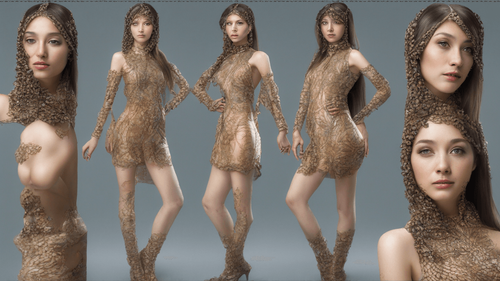
Unveiling the Power of Python for Image Super Resolution
Introduction to Image Super Resolution Python
In the digital age, where visual content dominates various industries, the demand for high-resolution images has never been higher. Image super resolution, often referred to as the process of enhancing the quality and detail of an image, has become a cornerstone in fields like photography, medical imaging, satellite imagery, and more. Harnessing the capabilities of Python, a versatile and powerful programming language, allows us to explore and implement sophisticated algorithms to achieve remarkable results.
The Power of Python for Image Super Resolution
Python, known for its simplicity and readability, has become the go-to language for various scientific and data-driven applications. When it comes to image super resolution, Python's extensive ecosystem of libraries and frameworks provides an arsenal of tools to tackle even the most complex challenges. The utilization of libraries such as TensorFlow, PyTorch, and OpenCV empowers developers to implement cutting-edge algorithms efficiently.
Understanding the Science Behind Image Super Resolution
At the heart of image super resolution lies the fusion of mathematics, machine learning, and signal processing. By comprehending the fundamental principles of image degradation and restoration, practitioners can make informed decisions on the most suitable approaches for different scenarios. Concepts like interpolation, convolutional neural networks (CNNs), and generative adversarial networks (GANs) play pivotal roles in achieving exceptional image enhancements.
Key Techniques for Image Super Resolution
Interpolation: Upscaling Basics
Interpolation serves as a foundational technique in image super resolution. Bicubic, Lanczos, and nearest-neighbor interpolation are among the methods used to upscale images. While these techniques provide simple solutions, they often lack the finesse and realism demanded by modern applications.
Convolutional Neural Networks (CNNs)
CNNs, a staple in deep learning, have revolutionized image super resolution. Through layers of convolutions, activations, and pooling, these networks learn intricate patterns within images and can generate high-resolution outputs. Architectures like SRCNN (Super-Resolution Convolutional Neural Network) have set benchmarks in this domain.
Generative Adversarial Networks (GANs)
GANs introduce a novel approach by pitting a generator against a discriminator, resulting in a dynamic learning process. This adversarial framework has yielded impressive results in generating high-quality images. Models like SRGAN (Super-Resolution Generative Adversarial Network) have showcased the true potential of GANs in image super resolution.
Essential Libraries for Image Super Resolution Python
TensorFlow: Powerhouse of Deep Learning
TensorFlow, an open-source machine learning library, boasts a plethora of tools for image super resolution. Its user-friendly APIs and pre-built models facilitate the development of intricate networks, while its compatibility with both CPUs and GPUs ensures optimal performance.
PyTorch: Flexibility and Innovation
PyTorch, known for its dynamic computational graph and intuitive interface, is a favorite among researchers and developers. Its flexibility enables the creation of custom architectures, making it a go-to choice for experimenting with novel image super resolution techniques.
OpenCV: Image Processing Wizardry
OpenCV, a versatile computer vision library, provides essential functions for image manipulation, filtering, and transformation. It serves as a vital component in preprocessing images before they undergo the super resolution process, ensuring optimal results.
Best Practices for Image Super Resolution
Quality Over Quantity
Prioritizing quality over excessive upscaling is essential. Super resolution should enhance an image's details without introducing artifacts or noise that diminish the overall aesthetic.
Dataset Diversity
A diverse training dataset comprising images from various sources and contexts fosters a more robust and adaptable model. This diversity enables the model to generalize better across different scenarios.
Hyperparameter Tuning
Experimenting with hyperparameters such as learning rates, batch sizes, and network architectures can significantly impact the final output's quality. Iterative refinement through tuning is key to achieving optimal results.
Frequently Asked Questions (FAQs)
How does image super resolution work? Image super resolution employs algorithms, often powered by machine learning, to upscale the resolution of an image while preserving and enhancing its details.
Can image super resolution restore lost image information? Image super resolution can recover some lost details, but it cannot recreate information that was not present in the original image.
What are the challenges in image super resolution? Challenges include avoiding overfitting, handling diverse image content, and balancing computational complexity with quality enhancements.
Is image super resolution a one-size-fits-all solution? No, the choice of technique and approach depends on factors such as the specific use case, available computing resources, and desired level of enhancement.
Are there any ethical considerations in image super resolution? Yes, image super resolution raises ethical concerns related to privacy, authenticity, and potential misuse of manipulated images.
Can I use image super resolution for video enhancement? Yes, the principles of image super resolution can be extended to video frames, enhancing the visual quality of videos.
Conclusion
In the captivating realm of image super resolution, Python emerges as an indispensable ally, empowering enthusiasts and experts alike to transform pixelated images into stunning visual marvels. With an array of techniques, libraries, and best practices at your disposal, you're poised to embark on a journey of creativity and innovation. As the world of image super resolution continues to evolve, Python remains a steadfast companion, driving the quest for unprecedented image quality.
Remember, mastery in image super resolution requires not only technical acumen but also a discerning eye for aesthetics. Embrace the art and science of enhancing images, and let Python be your guide in this thrilling expedition of pixel perfection.